window Alfa Romeo 4C 2014 Owner handbook (in English)
[x] Cancel search | Manufacturer: ALFA ROMEO, Model Year: 2014, Model line: 4C, Model: Alfa Romeo 4C 2014Pages: 190, PDF Size: 7.87 MB
Page 40 of 190
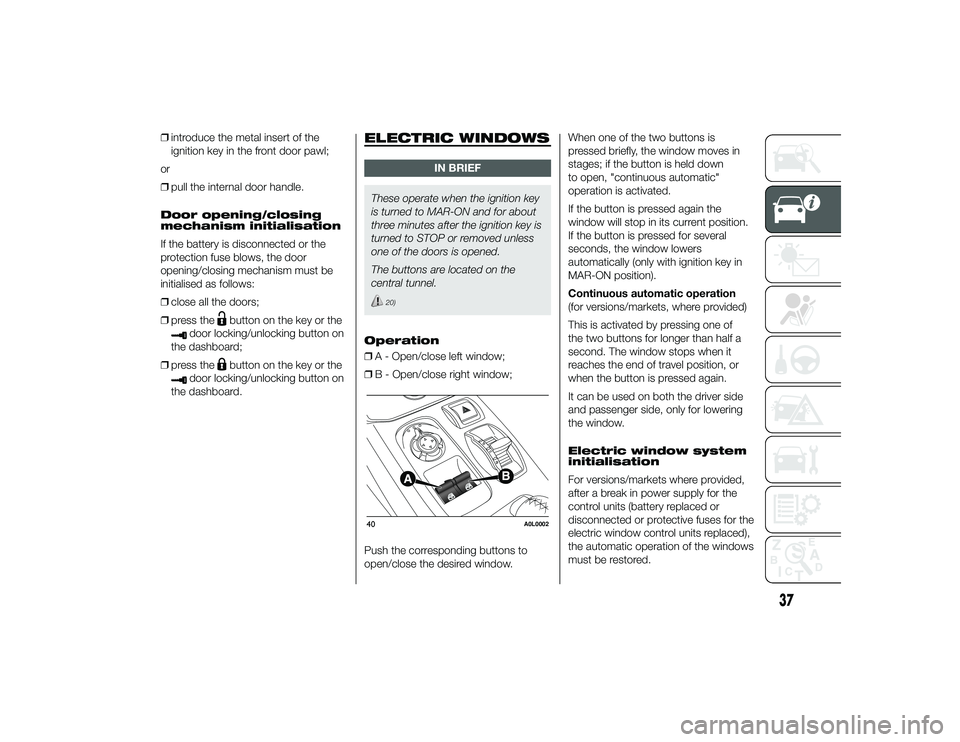
ŌØÆintroduce the metal insert of the
ignition key in the front door pawl;
or
ŌØÆ pull the internal door handle.
Door opening/closing
mechanism initialisation
If the battery is disconnected or the
protection fuse blows, the door
opening/closing mechanism must be
initialised as follows:
ŌØÆ close all the doors;
ŌØÆ press the
button on the key or the
door locking/unlocking button on
the dashboard;
ŌØÆ press the
button on the key or the
door locking/unlocking button on
the dashboard.
ELECTRIC WINDOWS
IN BRIEF
These operate when the ignition key
is turned to MAR-ON and for about
three minutes after the ignition key is
turned to STOP or removed unless
one of the doors is opened.
The buttons are located on the
central tunnel.
20)
Operation
ŌØÆ A - Open/close left window;
ŌØÆ B - Open/close right window;
Push the corresponding buttons to
open/close the desired window. When one of the two buttons is
pressed briefly, the window moves in
stages; if the button is held down
to open, "continuous automatic"
operation is activated.
If the button is pressed again the
window will stop in its current position.
If the button is pressed for several
seconds, the window lowers
automatically (only with ignition key in
MAR-ON position).
Continuous automatic operation
(for versions/markets, where provided)
This is activated by pressing one of
the two buttons for longer than half a
second. The window stops when it
reaches the end of travel position, or
when the button is pressed again.
It can be used on both the driver side
and passenger side, only for lowering
the window.
Electric window system
initialisation
For versions/markets where provided,
after a break in power supply for the
control units (battery replaced or
disconnected or protective fuses for the
electric window control units replaced),
the automatic operation of the windows
must be restored.40
A0L0002
37
24-9-2013 11:49 Pagina 37
Page 41 of 190
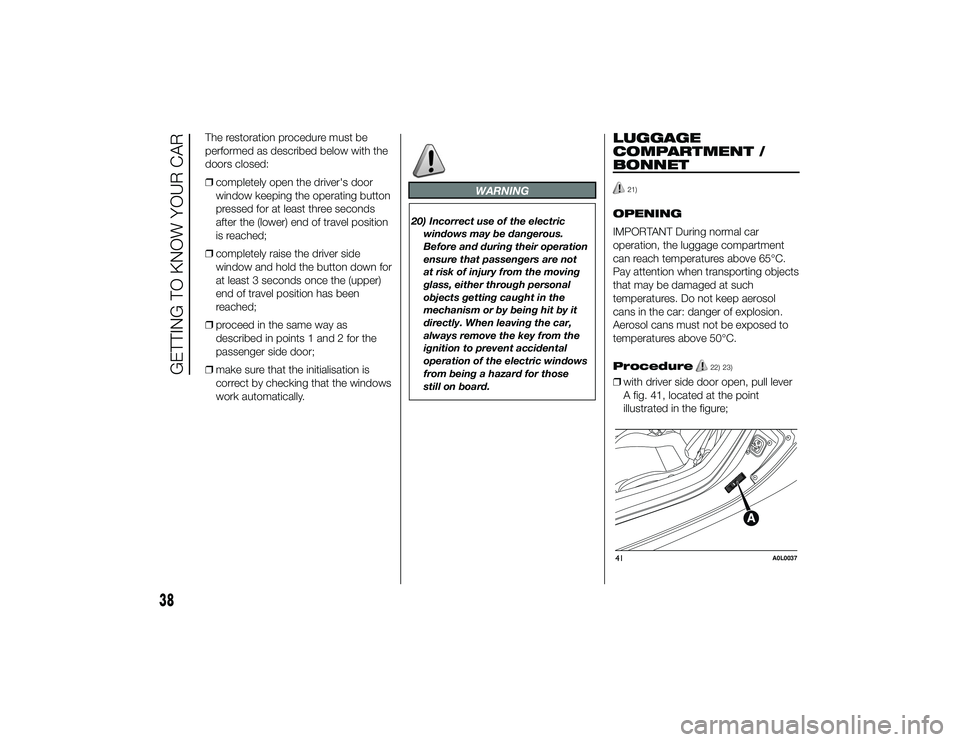
The restoration procedure must be
performed as described below with the
doors closed:
ŌØÆcompletely open the driver's door
window keeping the operating button
pressed for at least three seconds
after the (lower) end of travel position
is reached;
ŌØÆ completely raise the driver side
window and hold the button down for
at least 3 seconds once the (upper)
end of travel position has been
reached;
ŌØÆ proceed in the same way as
described in points 1 and 2 for the
passenger side door;
ŌØÆ make sure that the initialisation is
correct by checking that the windows
work automatically.
WARNING
20) Incorrect use of the electric
windows may be dangerous.
Before and during their operation
ensure that passengers are not
at risk of injury from the moving
glass, either through personal
objects getting caught in the
mechanism or by being hit by it
directly. When leaving the car,
always remove the key from the
ignition to prevent accidental
operation of the electric windows
from being a hazard for those
still on board.
LUGGAGE
COMPARTMENT /
BONNET
21)
OPENING
IMPORTANT During normal car
operation, the luggage compartment
can reach temperatures above 65┬░C.
Pay attention when transporting objects
that may be damaged at such
temperatures. Do not keep aerosol
cans in the car: danger of explosion.
Aerosol cans must not be exposed to
temperatures above 50┬░C.
Procedure
22) 23)
ŌØÆwith driver side door open, pull lever
A fig. 41, located at the point
illustrated in the figure;41
A0L0037
38
GETTING TO KNOW YOUR CAR
24-9-2013 11:49 Pagina 38
Page 42 of 190
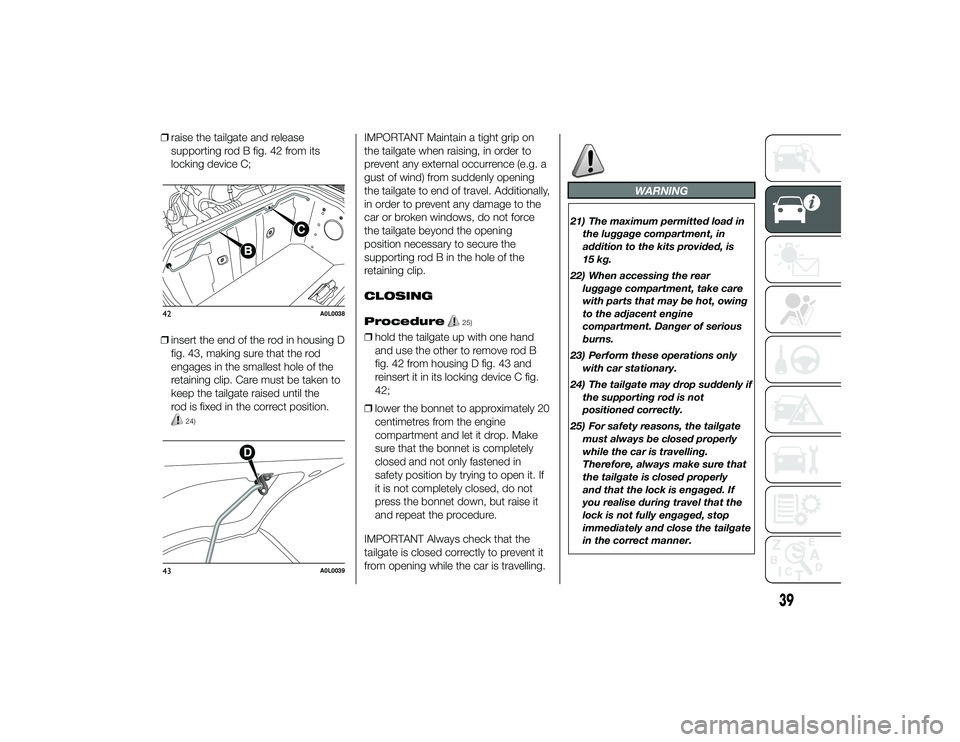
ŌØÆraise the tailgate and release
supporting rod B fig. 42 from its
locking device C;
ŌØÆ insert the end of the rod in housing D
fig. 43, making sure that the rod
engages in the smallest hole of the
retaining clip. Care must be taken to
keep the tailgate raised until the
rod is fixed in the correct position.
24)
IMPORTANT Maintain a tight grip on
the tailgate when raising, in order to
prevent any external occurrence (e.g. a
gust of wind) from suddenly opening
the tailgate to end of travel. Additionally,
in order to prevent any damage to the
car or broken windows, do not force
the tailgate beyond the opening
position necessary to secure the
supporting rod B in the hole of the
retaining clip.
CLOSING
Procedure
25)
ŌØÆhold the tailgate up with one hand
and use the other to remove rod B
fig. 42 from housing D fig. 43 and
reinsert it in its locking device C fig.
42;
ŌØÆ lower the bonnet to approximately 20
centimetres from the engine
compartment and let it drop. Make
sure that the bonnet is completely
closed and not only fastened in
safety position by trying to open it. If
it is not completely closed, do not
press the bonnet down, but raise it
and repeat the procedure.
IMPORTANT Always check that the
tailgate is closed correctly to prevent it
from opening while the car is travelling.
WARNING
21) The maximum permitted load in the luggage compartment, in
addition to the kits provided, is
15 kg.
22) When accessing the rear luggage compartment, take care
with parts that may be hot, owing
to the adjacent engine
compartment. Danger of serious
burns.
23) Perform these operations only with car stationary.
24) The tailgate may drop suddenly if the supporting rod is not
positioned correctly.
25) For safety reasons, the tailgate must always be closed properly
while the car is travelling.
Therefore, always make sure that
the tailgate is closed properly
and that the lock is engaged. If
you realise during travel that the
lock is not fully engaged, stop
immediately and close the tailgate
in the correct manner.
42
A0L0038
43
A0L0039
39
24-9-2013 11:49 Pagina 39
Page 101 of 190
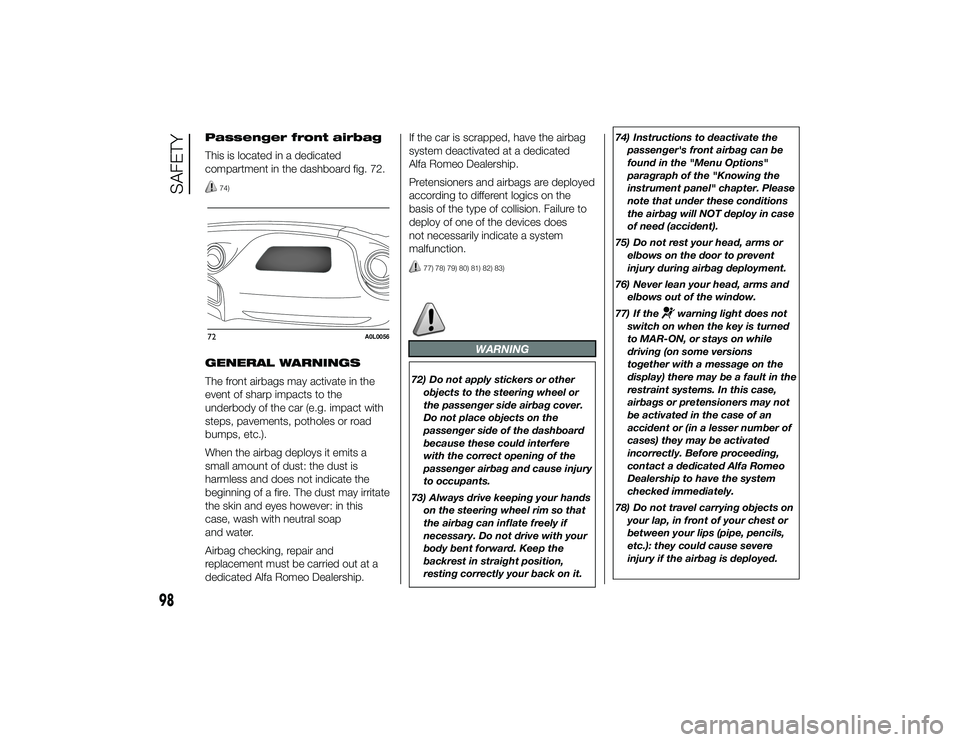
Passenger front airbag
This is located in a dedicated
compartment in the dashboard fig. 72.
74)
GENERAL WARNINGS
The front airbags may activate in the
event of sharp impacts to the
underbody of the car (e.g. impact with
steps, pavements, potholes or road
bumps, etc.).
When the airbag deploys it emits a
small amount of dust: the dust is
harmless and does not indicate the
beginning of a fire. The dust may irritate
the skin and eyes however: in this
case, wash with neutral soap
and water.
Airbag checking, repair and
replacement must be carried out at a
dedicated Alfa Romeo Dealership.If the car is scrapped, have the airbag
system deactivated at a dedicated
Alfa Romeo Dealership.
Pretensioners and airbags are deployed
according to different logics on the
basis of the type of collision. Failure to
deploy of one of the devices does
not necessarily indicate a system
malfunction.
77) 78) 79) 80) 81) 82) 83)
WARNING
72) Do not apply stickers or other
objects to the steering wheel or
the passenger side airbag cover.
Do not place objects on the
passenger side of the dashboard
because these could interfere
with the correct opening of the
passenger airbag and cause injury
to occupants.
73) Always drive keeping your hands on the steering wheel rim so that
the airbag can inflate freely if
necessary. Do not drive with your
body bent forward. Keep the
backrest in straight position,
resting correctly your back on it. 74) Instructions to deactivate the
passenger's front airbag can be
found in the "Menu Options"
paragraph of the "Knowing the
instrument panel" chapter. Please
note that under these conditions
the airbag will NOT deploy in case
of need (accident).
75) Do not rest your head, arms or elbows on the door to prevent
injury during airbag deployment.
76) Never lean your head, arms and elbows out of the window.
77) If the
warning light does not
switch on when the key is turned
to MAR-ON, or stays on while
driving (on some versions
together with a message on the
display) there may be a fault in the
restraint systems. In this case,
airbags or pretensioners may not
be activated in the case of an
accident or (in a lesser number of
cases) they may be activated
incorrectly. Before proceeding,
contact a dedicated Alfa Romeo
Dealership to have the system
checked immediately.
78) Do not travel carrying objects on your lap, in front of your chest or
between your lips (pipe, pencils,
etc.): they could cause severe
injury if the airbag is deployed.
72
A0L0056
98
SAFETY
24-9-2013 11:50 Pagina 98
Page 114 of 190

SNOW TYRESUse snow tyres of the same size as the
normal tyres provided with the car:
the dedicated Alfa Romeo Dealership
will be able to advise you on the most
appropriate tyre to use.
Only use these tyres in the event of ice
or snow on the roads.
For the type of tyre to be used, inflation
pressures and the specifications of
snow tyres, follow the instructions given
in the "Wheels" paragraph in the
"Technical specifications" chapter.
90)
The performance of these tyres on
low-grip surfaces are reduced
considerably when the tread depth is
below 4 mm. They should be replaced
in this case.
Due to the specific characteristics of
snow tyres, in normal weather
conditions or on long motorway
journeys, the performance of these
tyres is lower than that of standard
tyres. Their usage should therefore be
restricted in accordance with their
type approval.IMPORTANT When using snow tyres
with a maximum speed index below the
one that can be reached by the car
(increased by 5%), place a notice in the
passenger compartment, plainly in
view, which states the maximum speed
allowed by the snow tyres (as per EC
Directive).
All four tyres should be the same brand
to ensure greater safety when driving
and braking as well as making the
car more responsive. It is inadvisable to
change the rotation direction of tyres.
Refer to the "Raising the car" section in
the "In an emergency" chapter for
further details on how to raise the car
correctly.
WARNING
90) The maximum speed for snow
tyres marked ŌĆ£QŌĆØ is 160 km/h,
while it is 190 km/h for ŌĆ£TŌĆØ tyres
and 210 km/h for "H" tyres. The
highway code speed limits must
however always be complied with.
CAR INACTIVITYIf the car is to be left inactive for longer
than a month, observe the following
precautions:
ŌØÆpark the car in covered, dry and if
possible well-ventilated premises and
slightly open the windows;
ŌØÆ check that the handbrake is not
engaged;
ŌØÆ disconnect the negative battery
terminal and check the battery
charge. Repeat this check once
every three months during storage.
For optimum preservation of the
battery charge, it is advisable to use
the charge-holder (for versions/
markets, where provided, or
alternatively, available from
Lineaccessori). For more details on
its operation, refer to the attached
Supplement;
ŌØÆ if the battery is not disconnected
from the electrical system, checks its
state of charge every thirty days;
ŌØÆ clean and protect the painted parts
using protective wax;
111
24-9-2013 11:50 Pagina 111
Page 131 of 190

ENGINE COMPARTMENT FUSE BOX
fig. 103DEVICE PROTECTEDFUSEAMPERE
Headlight beam switch (for versions/markets, where provided) F095
Single tone horn F1010
12 V socket / cigar lighter F8615
External mirror defrosters F887.5
.
DASHBOARD FUSE BOX
fig. 105DEVICE PROTECTED FUSEAMPERE
Central locking F3815
Two-way windscreen washer pump F4320
+30 Driver side electric windows F4720
+30 Passenger side electric windows F4820
128
IN AN EMERGENCY
24-9-2013 11:50 Pagina 128
Page 153 of 190

PRESERVING THE
BODYWORK
Paintwork
5)
27) 28)
Touch up abrasions and scratches
immediately.
Maintenance of paintwork consists of
washing the car: the frequency
depends on the conditions and
environment where the car is used. For
example, in highly polluted areas, or if
the roads are spread with salt, it is
advisable to wash the car more
frequently.
To correctly wash the car, proceed as
follows:
ŌØÆif high pressure jets or cleaners are
used to wash the car, keep a
distance of at least 40 cm from the
bodywork to avoid damage or
alteration. It should be remembered
that the build up of water can
damage the car over a period of
time;
ŌØÆ wash the bodywork using a low
pressure jet of water;
ŌØÆ wipe a sponge with a slightly soapy
solution over the bodywork,
frequently rinsing the sponge;
ŌØÆ rinse well with water and dry with a
jet of air or a chamois leather. Dry the less visible parts (e.g. door
frames, bonnet, headlight frames, etc.)
with special care, as water may
stagnate more easily in these areas.
The car should not be taken to a closed
area immediately, but left outside so
that residual water can evaporate.
Do not wash the car after it has been
left in the sun or with the tailgate hot:
this may alter the shine of the
paintwork.
Exterior plastic parts must be cleaned
in the same way as the rest of the car.
Avoid parking under trees as much
as possible; the resin from trees dulls
the paintwork.
IMPORTANT Bird droppings must be
washed off immediately and thoroughly
as the acid they contain is particularly
aggressive.
Windows
Use specific detergents and clean
cloths to prevent scratching or altering
the transparency.
Front headlights
Use a soft cloth soaked in water and
detergent for washing cars.
IMPORTANT Never use aromatic
substances (e.g. petrol) or ketenes (e.g.
acetone) for cleaning the plastic lenses
of the front headlights.
Engine compartment
At the end of the winter the engine
compartment should be carefully
washed, without directing the
jet against any electronic control unit.
Have this operation performed at a
specialised workshop.
IMPORTANT The washing should take
place with the engine cold and the
ignition key in the STOP position. After
the washing operation, make sure
that the various protections (e.g. rubber
caps and guards) have not been
removed or damaged.
150
SERVICING AND MAINTENANCE
24-9-2013 11:50 Pagina 150
Page 176 of 190

UseFluid and lubricant specifications for a correct
use of the car Genuine fluids and
lubricants Applications
Protective agent
for radiators Red protective agent with antifreeze action, based
on inhibited monoethylene glycol with organic
formula. Exceeds CUNA NC 956-16, ASTM D
3306 specifications.
FIAT 9.55523 classification PARAFLU
UP
(*)
Contractual Technical
Reference No. F101.M01 Usage percentage:
50% demineralised
water 50%
PARAFLU
UP
(**)
Windscreen
washer fluid Mixture of alcohol, water and surfactants CUNA
NC 956-11
FIAT 9.55522 classification TUTELA
PROFESSIONAL SC 35
Contractual Technical
Reference No. F201.D02To be used diluted or
undiluted in
windscreen/rear
window washer/wiper
systems
(*)IMPORTANT Do not top up or mix with other fluids which have different specifications from those described.
(**)When the vehicle is used in particularly harsh weather conditions, we recommend using a mixture of 60%
PARAFLU
UPand 40% demineralised water.
173
24-9-2013 11:50 Pagina 173
Adhesive for
glassesMS Polymer
base adhesive
FIAT 9.55738/C classification SIMSON ISR 70-08 APSticking the glasses on
the body
Page 180 of 190

WHAT TO DO IF
FaultPossible solution
... A TYRE IS PUNCTURED. Use the Fix&Go tyre repair kit.See page 115.
... A TYRE DEFLATES. Restore the correct pressure. See page 166.
... THE BATTERY IS FLAT. -See page 129 or contact a
dedicated Alfa Romeo Dealership.
... THE INTERNAL ROOF LIGHT DOES NOT SWITCH ON. Replace the bulb.See page 125 or contact a
dedicated Alfa Romeo Dealership.
... THE LUGGAGE COMPARTMENT ROOF LIGHT DOES NOT SWITCH ON. Replace the bulb.See page 125 or contact a
dedicated Alfa Romeo Dealership.
... AN EXTERNAL BULB (main beam, dipped beam headlights...) DOES NOT COME ON. -
Contact a dedicated Alfa
Romeo Dealership.
Replace the bulb. See page 122 or contact a
dedicated Alfa Romeo Dealership.
... THE REMOTE CONTROL DOES NOT WORK. Replace the batteries inside the remote
control. See page 12.
... AN ELECTRIC WINDOW DOES NOT WORK. Check the relevant protection fuse.
See page 126 or contact a
dedicated Alfa Romeo Dealership.
Have the relevant window raising / lowering motor checked Contact a dedicated Alfa
Romeo Dealership.
24-9-2013 11:50 Pagina 177
Page 185 of 190
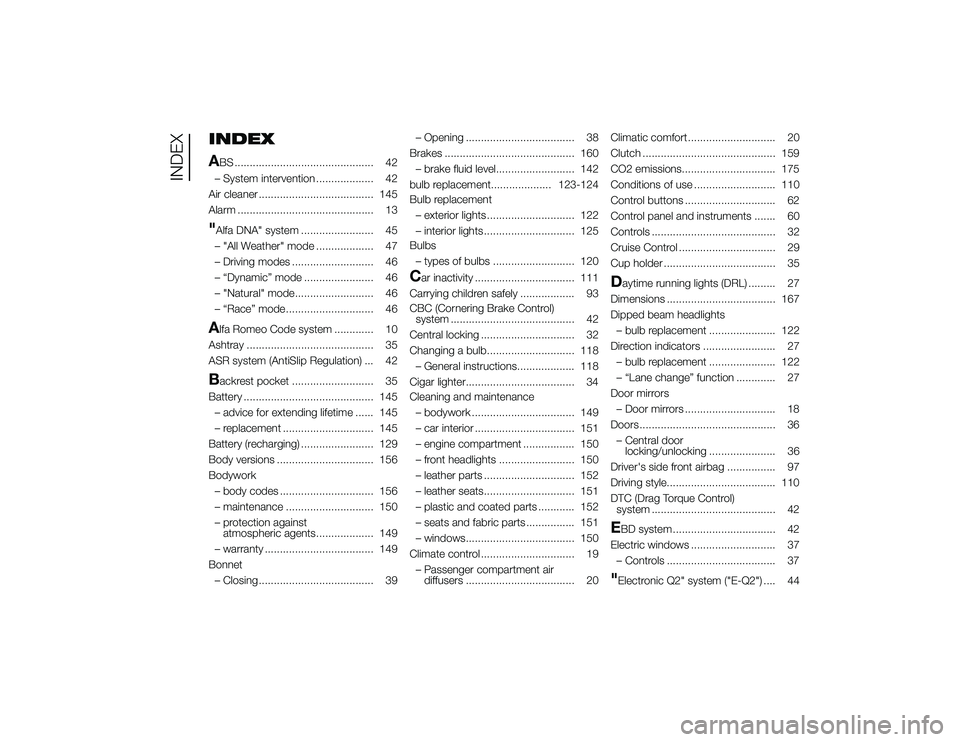
INDEX
ABS .............................................. 42
ŌĆō System intervention ................... 42
Air cleaner ...................................... 145
Alarm ............................................. 13"Alfa DNA" system ........................ 45
ŌĆō "All Weather" mode ................... 47
ŌĆō Driving modes ........................... 46
ŌĆō ŌĆ£DynamicŌĆØ mode ....................... 46
ŌĆō "Natural" mode.......................... 46
ŌĆō ŌĆ£RaceŌĆØ mode............................. 46Alfa Romeo Code system ............. 10
Ashtray .......................................... 35
ASR system (AntiSlip Regulation) ... 42Backrest pocket ........................... 35
Battery ........................................... 145 ŌĆō advice for extending lifetime ...... 145
ŌĆō replacement .............................. 145
Battery (recharging) ........................ 129
Body versions ................................ 156
Bodywork ŌĆō body codes ............................... 156
ŌĆō maintenance ............................. 150
ŌĆō protection against atmospheric agents................... 149
ŌĆō warranty .................................... 149
Bonnet ŌĆō Closing ...................................... 39 ŌĆō Opening .................................... 38
Brakes ........................................... 160 ŌĆō brake fluid level.......................... 142
bulb replacement.................... 123-124
Bulb replacement ŌĆō exterior lights ............................. 122
ŌĆō interior lights .............................. 125
Bulbs
ŌĆō types of bulbs ........................... 120
Car inactivity ................................. 111
Carrying children safely .................. 93
CBC (Cornering Brake Control) system ......................................... 42
Central locking ............................... 32
Changing a bulb............................. 118 ŌĆō General instructions................... 118
Cigar lighter.................................... 34
Cleaning and maintenance ŌĆō bodywork .................................. 149
ŌĆō car interior ................................. 151
ŌĆō engine compartment ................. 150
ŌĆō front headlights ......................... 150
ŌĆō leather parts .............................. 152
ŌĆō leather seats.............................. 151
ŌĆō plastic and coated parts ............ 152
ŌĆō seats and fabric parts ................ 151
ŌĆō windows.................................... 150
Climate control ............................... 19 ŌĆō Passenger compartment air diffusers .................................... 20 Climatic comfort ............................. 20
Clutch ............................................ 159
CO2 emissions............................... 175
Conditions of use ........................... 110
Control buttons .............................. 62
Control panel and instruments ....... 60
Controls ......................................... 32
Cruise Control ................................ 29
Cup holder ..................................... 35
Daytime running lights (DRL) ......... 27
Dimensions .................................... 167
Dipped beam headlights ŌĆō bulb replacement ...................... 122
Direction indicators ........................ 27 ŌĆō bulb replacement ...................... 122
ŌĆō ŌĆ£Lane changeŌĆØ function ............. 27
Door mirrors ŌĆō Door mirrors .............................. 18
Doors ............................................. 36 ŌĆō Central door locking/unlocking ...................... 36
Driver's side front airbag ................ 97
Driving style.................................... 110
DTC (Drag Torque Control) system ......................................... 42EBD system .................................. 42
Electric windows ............................ 37 ŌĆō Controls .................................... 37"Electronic Q2" system ("E-Q2") .... 44
INDEX